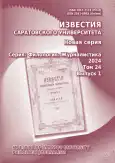The article reviews the International Conference “Modern speech communication in different spheres of society” that took place on October 20–21, 2023, at the Institute of Philology and Journalism of Saratov State University. The conference was dedicated to a unique event – the 100th anniversary of SSU professor, an outstanding linguist, Olga Borisovna Sirotinina. Researchers from different cities of Russia and different countries (Armenia, Poland, Mongolia) responded to this significant event. At the opening of the conference welcoming words were said by the Deputy-Rector for Research and Digital Development of SSU A. A. Koronovsky; Head of the Department of General Literary Studies and Journalism, Professor of SSU V.V. Prozorov; Head of Priority Projects and Programs, Professor of SSU E. G. Elina; Professor of the State Institute of Russian Language named after A. S. Pushkin, Chairman of the Russian Association of Researchers, Teachers and Teachers of Rhetoric V. I. Annushkin. The speakers emphasized the timeliness and significance of the conference, and highly appreciated the many years of scientific activity of O. B. Sirotinina. The article provides a brief overview of plenary and sectional reports. At the plenary session, such problems were raised as those of the history and formation of linguistic science in Saratov, and the development by O. B. Sirotinina and V. E. Goldin of the theory of types of speech culture. Some of the reports were dedicated to O. B. Sirotinina as a wonderful researcher, a unique person, the author of the book of memoirs “Life regardless, or I am a happy person” and personal diaries “And life will fly by like a dream...”. The sections were dedicated to the following areas: “Modern speech communication in the educational environment of universities and schools”, “Spoken speech and its place in the modern communicative space”, “Speech culture and its formation in modern communicative practices”, “Institutional discourse and issues in studying this discourse”, “Media sphere and media language”. The conference has become a historic occasion in the life of Saratov State University.
 4-11
4-11


 12-19
12-19


 20-25
20-25


 26-32
26-32


 33-38
33-38


 39-46
39-46


 47-54
47-54


 55-61
55-61


 62-69
62-69


 70-77
70-77


 78-84
78-84


 85-89
85-89


 90-98
90-98


 99-110
99-110


 111-114
111-114


 115-120
115-120











